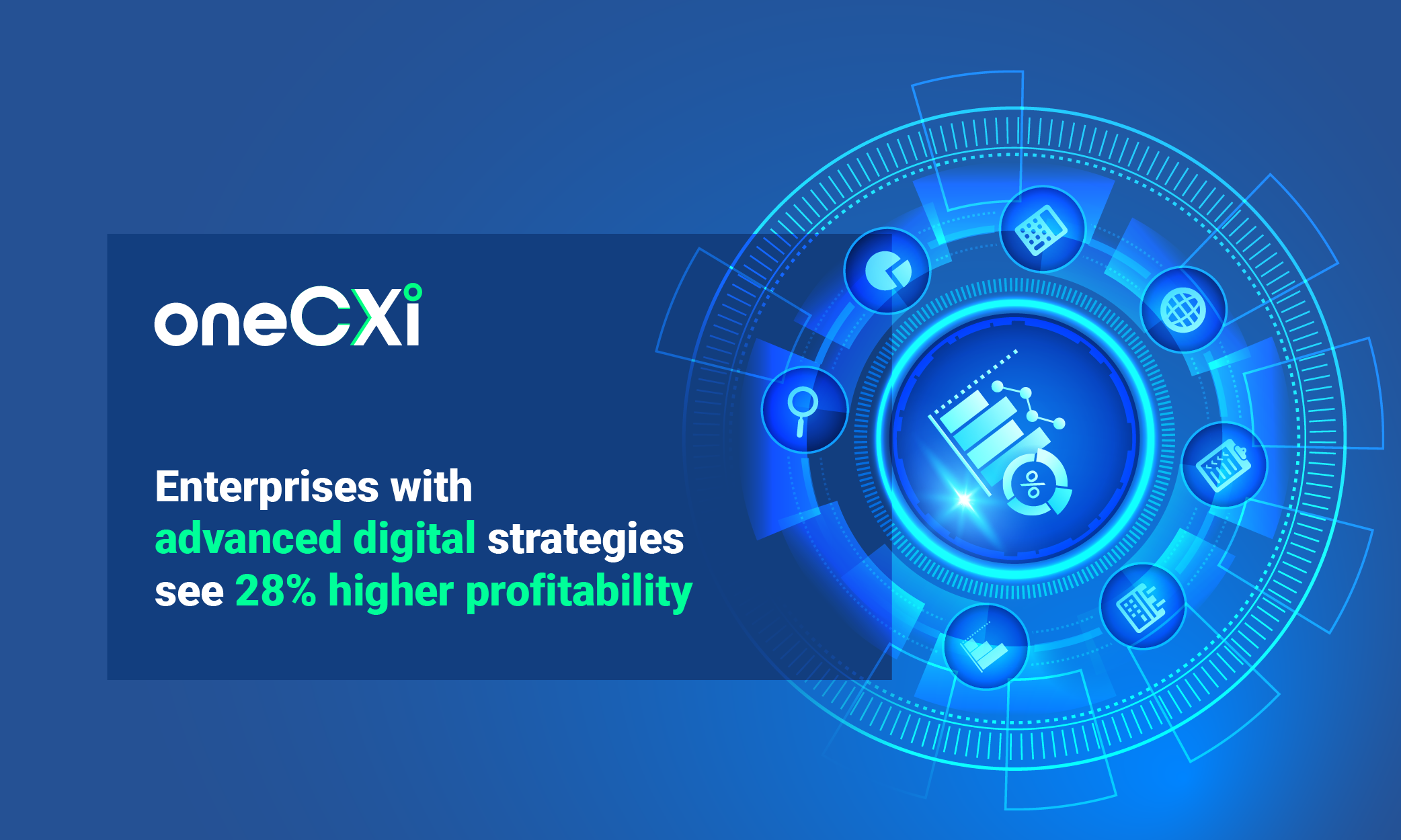- Resources
- What is Digital Strategy? [Key Benefits + Examples]
What is Digital Strategy? [Key Benefits + Examples]

The term ‘digital strategy’ might initially seem vague, but it’s one of the most important pieces of your business plan. And yes, some argue there’s no need for the term since almost every other business today is digital, making your business strategy the same as your digital strategy.
However, having a clear and focused digital strategy is important when successfully navigating complex projects. Digital strategy is about using technology to improve business performance by creating new products or streamlining current processes.
It’s a roadmap that helps you leverage technology to create competitive advantages and reach your business goals. Read along as we discuss more about the digital strategy meaning, its benefits and how you can set up the perfect digital business strategy!
In this article, we will explore:
What Is Customer Onboarding?
The customer onboarding process focuses on nurturing new customers—ensuring they are properly set up, familiar with your product, and comfortable using it. The purpose of customer onboarding is to provide value to your consumers as soon as possible so that they continue to return to your product and quickly embrace it as part of their regular work routine.
What is Digital Strategy?
A digital strategy is an umbrella term for employing technology to boost your brand’s online visibility. It involves:
- Changing how a company operates and provides value
- Recognizing consumer wants
- Optimizing operations
- Using data to cultivate an agile and innovative company culture
Essentially, a digital business strategy is all about aligning technology initiatives with company objectives and consumer needs, ensuring that technology expenditures result in better outcomes. A great digital strategy identifies the right technologies, defines how to adopt them, and uses them to achieve a competitive advantage.
For example, a digital marketing firm may choose technologies that assist them with digital channels such as social media and email.
Digital Strategy Vs. Digital Transformation
A digital strategy focuses on leveraging specific technologies to enhance business processes, customer experiences, or operations. Digital transformation, on the other hand, is a more comprehensive term that defines how a company operates and delivers value using various digital tools.
Below is a table that breaks down the key differences:

Benefits of Digital Strategy for Businesses
A digital business strategy guarantees that the entire team works together to achieve the company’s objectives and goals. Let’s explore the benefits of this strategy in a little more detail:
Deep Understanding of Your Target Audience
Once you’ve developed a digital strategy, you can think predominantly about your target audience. And when you’re completely familiar with your target demographic, you can effortlessly change your web marketing tactics.
You may also build innovative marketing messaging, identify the ideal digital platforms, and create effective CTAs. That is exactly how you may avoid wasting time testing alternative marketing messages. You can also assess which audience is most appropriate to reach out to.
Clear Objectives and Measurable Benchmarks
With a digital plan, you can direct your marketing efforts more effectively. It also helps to outline all of the necessary tactical actions. As a result, selecting an effective platform for communicating with online audiences becomes challenging without first setting precise goals. When you create a captivating digital strategy, your organization can effortlessly meet specific targets.
Concerted Efforts
The most effective digital marketing initiatives use numerous channels while working together to achieve a single goal. However, when you’re focused on multiple channels at once, distinct campaigns can lose cohesion or strength. A well-defined digital marketing strategy keeps all your initiatives coordinated and moving in the right direction.
Optimization Across Channels
With competition on digital channels at an all-time high, there is limited room for ineffective initiatives. However, it can be difficult to maintain things optimal when performing multichannel campaigns.
You must discover the appropriate measurements, analyze your data properly, make informed decisions, and adjust to changing patterns. Your digitalization strategy can help keep everything optimized and on track with your organization’s objectives.
Your digitalization strategy can help keep everything optimized and on track with your objectives. Social media management platforms like Circleboom support multichannel posting, analytics, and automation to maintain consistent optimization
Improved Brand Recognition
An effective digital strategy may include a digital marketing plan, which allows marketers to broaden the brand’s reach on the Internet. Social media posting calendars, scheduled email marketing, digital resource management, and analytics are all important components of establishing a robust online presence. By raising brand awareness, marketers can inspire potential customers to interact with the brand and uncover new revenue streams.
Engagement with Mobile Customers
Thanks to the development of smartphones, we may now browse web pages on more than one screen. This implies that people may use their cell phones to look for things they want and even customize their search results.
For businesses, a digitalization strategy that focuses on mobile experiences can boost focused consumer outreach and make it easier for enterprises to create great customer relationships, another critical requirement for success in the digital age.
Competitive Market Insights
This metric refers to the percentage of total sales or revenue captured by a specific company or brand in a certain market. It is significant because it indicates a company’s relative competitive position in a market and can be used as a key performance statistic to monitor growth or decline over time.
When your digital marketing strategy is linked to increasing your brand’s market share, your campaigns become more focused on your business’s important outcomes.
Improved Budgeting
A digitalization strategy improves budgeting by providing a more complete picture of what your marketing team is working on. This lets you efficiently deploy resources, maximizing the ROI of your marketing activities. When you have a clear view of where your marketing budget is going, it’s easier to argue for increased budgets and resources.
Enhanced Data Collection
Many businesses have an online presence through their website or social media networks. These channels collect massive volumes of customer data daily, and a good digitalization strategy may assist marketers and salespeople in collecting and managing this data.
Moreover, analytics tools use cookies and other data-collecting techniques to discover trends in site visitor traffic and social media participation. This data can assist marketers in identifying the company’s target population and creating campaigns that appeal to potential buyers.
How to Create a Digital Strategy Roadmap

A digital strategy establishes a defined approach for aligning your strategic vision with concrete goals, ensuring that your transformation efforts are focused and measurable. Here’s a step-by-step process for creating a successful digital strategy roadmap:
Choose a Leader to Drive Your Digital Strategy
This person needs to have a strong understanding of your products, IT infrastructure, and customer needs. They will align your digital transformation efforts with business goals, focusing on customer-centric initiatives.
Assess the Current Impact of Digitalization
Analyze how digitalization currently affects your business, particularly in customer-facing areas. Break this down into two approaches:
- Attack: Implement new technologies or services to improve customer interaction and satisfaction.
- Defend: Safeguard your company from digital threats and ensure customer data security and privacy.
By understanding both, you can create a strategy that pushes your business forward and shields your customers from potential digital risks.
Explore Relevant Technologies
Focus on tools that enhance customer engagement, such as AI-powered chatbots, CRM systems (customer relationship management), or automation software. Moreover, select technologies that will directly improve customer experience and satisfaction by offering personalized, timely, and seamless interactions.
Set Bold and Measurable Goals
Consider where digital enhancements can have the most significant impact on your customers. For example, can you reduce response times or make your website more user-friendly?
Also, setting SMART goals (Specific, Measurable, Achievable, Relevant, and Time-bound) will help you track progress and ensure that every digital initiative contributes to a better customer experience.
Address Digital Skill Gaps
Conduct a skills gap analysis to assess where training is needed. This will help you upskill employees in digital marketing, data analytics, or customer service automation, ensuring they can effectively implement new tools to improve customer engagement.
Test, Iterate, and Optimize
Before fully implementing your digital strategy, test it on a smaller scale. Pilot programs can help you identify potential roadblocks and allow adjustments before going live. During this phase, collect employee and customer feedback to fine-tune your approach. Use KPIs (key performance indicators) like customer satisfaction scores or engagement rates to measure the effectiveness of your digital roadmap.
Key Elements of a Digital Strategy

A well-executed strategy drives engagement and ensures seamless interactions at every touchpoint. Here are the critical elements you should focus on:
SMART Goals
Your strategy should begin with clear SMART goals—Specific, Measurable, Achievable, Relevant, and Time-bound objectives. These goals keep you focused and provide a roadmap for success. For example, if you aim to boost customer engagement, define what that means. Is it increasing social media interaction by 20% in three months? Be specific.
Market and Competitors
Effective digital strategies are rooted in research. To refine your approach, thoroughly analyze your market trends, target audience, and competitors. Market research helps you understand customer behaviors, including what they buy and why. Also, dive deeper into what your competitors are doing well and where they fall short.
Target Audience
Knowing who your potential customers are enables you to tailor content, products, and services to their needs. This includes understanding their demographics (age, gender, location) and psychographics (lifestyle, interests). Also, creating user personas—detailed profiles of your ideal customers—helps you craft targeted messaging and strategies.
User Journey
User journeys represent the steps they take from first becoming aware of your product to making a purchase or converting. By mapping out this journey, you can identify areas where you might lose them and optimize these touchpoints. For example, if a customer first finds you through a social media ad, make sure that the link leads them to a page that matches their expectations.
Key Performance Indicators (KPIs)
Each KPI should tie directly to one of your SMART goals. These could include website traffic, conversion rates, or social media engagement. For instance, if your goal is to drive conversions but you see low results on a landing page, it may signal the need to tweak the design or call-to-action (CTA) buttons.
Launch Plan
This outlines the step-by-step process for rolling out your digital initiatives—whether it’s a new website, a series of social media campaigns, or a product launch. Include a timeline with clear deadlines to keep everyone on track.
5 Examples of Digital Strategy
After all that theoretical knowledge, let’s look at some real-life examples that have successfully implemented a digital strategy and the results that have achieved:
Deltin
Deltin Royale embraced personalized video content using GenAI to reconnect with dormant customers. Through an exclusive video invite featuring a brand ambassador, they revived 16% of inactive customers and saw a 3X revenue boost. This strategy created a direct, personalized touchpoint with customers, increasing engagement and securing 100% event bookings.
Muthoot
Muthoot’s digital strategy blended customer engagement and luxury through WhatsApp chatbots and digital catalogs. Instead of traditional retail, they deployed a ‘phygital’ (physical + digital) model that allowed customers to view jewelry online while completing purchases in trusted branches. This approach kept costs low and maintained a high-quality customer experience, increasing sales and deeper customer trust.
Spotify
Spotify excels at personalization by creating tailored playlists like ‘Discover Weekly’ based on your listening habits. This algorithm-driven approach helps you discover new music and feel valued. Their consistent app design across platforms ensures a unified experience whether you use a phone or desktop. With podcasts, audiobooks, and exclusive content, Spotify offers variety, keeping users hooked on the app.
Duolingo
Duolingo delivers a gamified language learning experience that keeps users engaged. You earn points (XP), unlock levels, and collect badges as you progress, making learning enjoyable. The app also adapts lessons based on your performance, suggesting topics to revise or advance. Personalized push notifications remind you to stay on track, ensuring consistency in learning without feeling intrusive.
Uber
Uber simplified the cab-hailing experience by addressing customer pain points such as waiting times, payments, and availability. The app also considered driver needs, offering flexible working options and reliable payment systems. By creating an app catered to customers and drivers, Uber changed how ride-sharing works, leading to millions of loyal users and a positive experience on both sides of the transaction.
How Ozonetel Can Help in Implementing Digital Strategy
Ozonetel allows you to deliver exceptional customer experiences at scale through personalized, omnichannel interactions. Here’s how:
- Streamline customer journeys with AI-powered orchestration
- Run cross-channel conversational marketing campaigns at scale
- Enhance customer support with AI-powered self-service chatbots
- Boost sales and service with seamless omnichannel engagement
- Leverage conversational intelligence to improve CX and agent training
Conclusion
A successful digital strategy depends largely on leveraging data across all customer touchpoints. And you can do this by always having a real-time view of your digital channels and operational insights. However, this requires tools beyond manual efforts to analyze structured and unstructured data, transforming it into actionable insights.
With Ozonetel’s customer experience solutions, you can streamline your digital customer journey, making every interaction count. From omnichannel engagement to AI-powered analytics, Ozonetel helps you optimize your digital strategy for higher satisfaction and sustained growth.
Want to see what Ozonetel can do for your company? Sign up today for a free 7-day trial.
Prashanth Kancherla
Chief Operating Officer, Ozonetel Communications
Over the past decade, Prashanth has worked with 3000+ customer experience and contact center leaders...
Chief Operating Officer, Ozonetel Communications
Over the past decade, Prashanth has worked with 3000+ customer experience and contact center leaders to comprehensively understand the need for effective and efficient customer communications at every step of their journey with a brand. Deeply embedded in today’s CCaaS ecosystem, he has been instrumental in Ozonetel's growth and contributed in various roles including product management, sales, and solution architecture.
Frequently Asked Questions
A digital strategy refers to a plan that outlines how an organization will use digital technologies to meet its business objectives. It includes various aspects such as marketing, operations, customer engagement, and data management to create a comprehensive approach that allows you to seamlessly navigate digital challenges.
The four pillars of a digital strategy are customer experience, operational processes, business model, and technology. Each pillar is essential for helping organizations respond to market changes, improve customer satisfaction, and drive growth through effective digital solutions.
The three layers of digital strategy consist of the foundational layer, operational layer, and transformational layer. The foundational layer focuses on building the necessary technology and infrastructure, the operational layer emphasizes improving processes and customer interactions, while the transformational layer targets innovation and adapting to changing market conditions.







